Estimated reading time: 23 minutes
When you’re hunkered down in a shelter or simply can’t go out to shop or even wild forage, you have to make the best of what you have. That can be a challenge when your stockpile is running low and especially if you never got around to stockpiling in the first place.
Here are some tricks from professional chefs on how to improvise meals from some meager basics you might still have on hand.
Want to save this post for later? Click Here to Pin It On Pinterest!
The Challenge Defined
This story is about a challenge. A simple, hypothetical problem that many have confronted in the past and many more may encounter in the future. Here’s the dilemma: For whatever reason, a person or family is trapped in their house for an indeterminate amount of time because it’s unsafe to go outside.
- A nuclear accident has occurred and all residents are advised to stay inside their homes.
- A pandemic is peaking and people are encouraged not to venture outside. Most stores are closed and all services are limited.
- Civil unrest has simply made the streets unsafe.
- A severe and catastrophic weather event has made the roads impassable and any travel is impossible. In addition, many if not all basic services are affected from grocery stores to gas stations.
- A person is alone and either injured or disabled and assistance cannot reach them.
It’s a set of desperate survival challenges that would require multiple solutions, and one of those solutions is related to food. But for many, that can emerge as one of their greatest challenges. There are always delivery options through companies like Amazon and others, but if no one else can travel, those options may be out of reach.
Prepared or Not?
Some people are prepared and have a sufficient stockpile of supplies and equipment to weather the disaster. Others are caught off guard and are confronted with limited resources. But even the prepared family may find that their supplies are running short if the disaster is of long duration and travel is impossible. The end result is that something as basic as finding and making something to eat becomes a growing challenge if not a major threat to continuing survival.
How Our Pioneer Ancestors Prepared
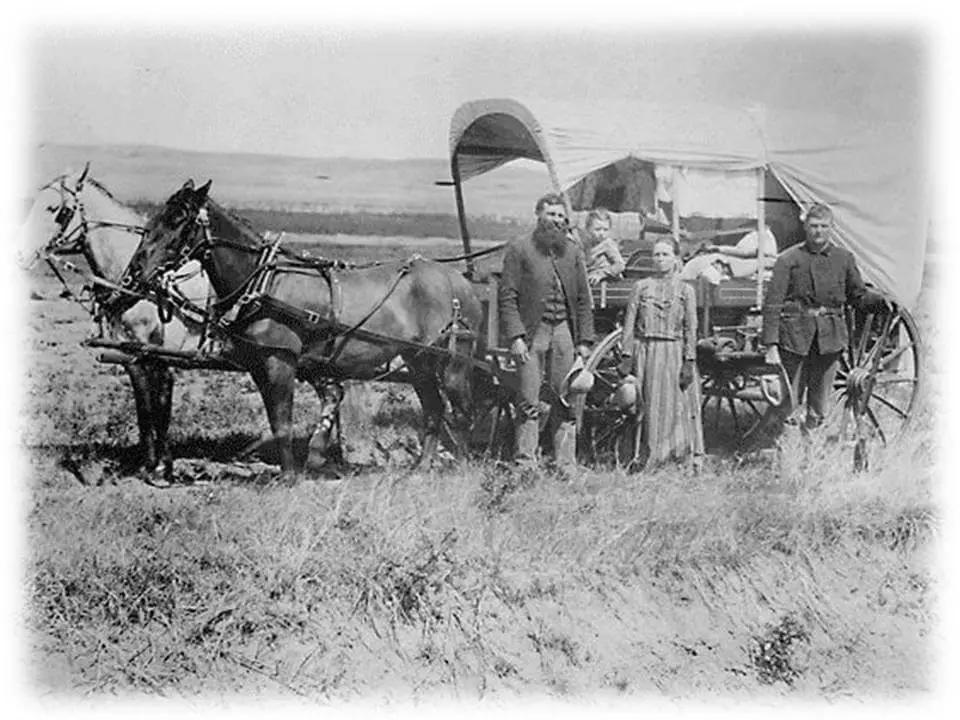
As pioneers traveled across the plains and the mountains they transported something called a “grubstake.” A grubstake is a specific supply of food staples that could be used to make a variety of meals that satisfied basic needs from calories to nutrition.
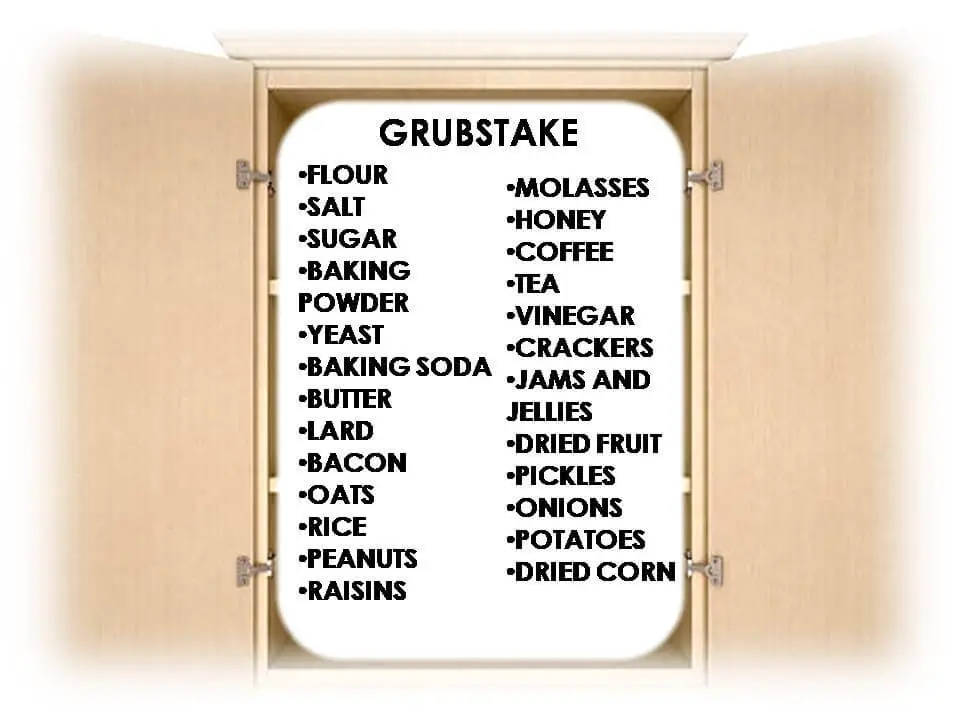
It’s an impressive list and an accomplished cook could do a lot with these ingredients. But that was the past and for many people today the food they still have on hand when supplies run low make the old grubstake look like a feast.
This isn’t about taking a pioneer grubstake and making meals. It’s about taking the accidental and meager collection of food stuffs leftover in a panty after a disaster and improvising meals. And it gets worse.
And Here’s The Challenge…
- There is no electricity so refrigerated and frozen foods are long since gone.
- Fresh fruits and vegetables have already been consumed or rotted due to lack of refrigeration.
- There’s no conventional way to cook anything.
- Water is still abundant but few if any of the remaining food items can make a decent meal on their own.
Here’s Our Last Gasp Pantry
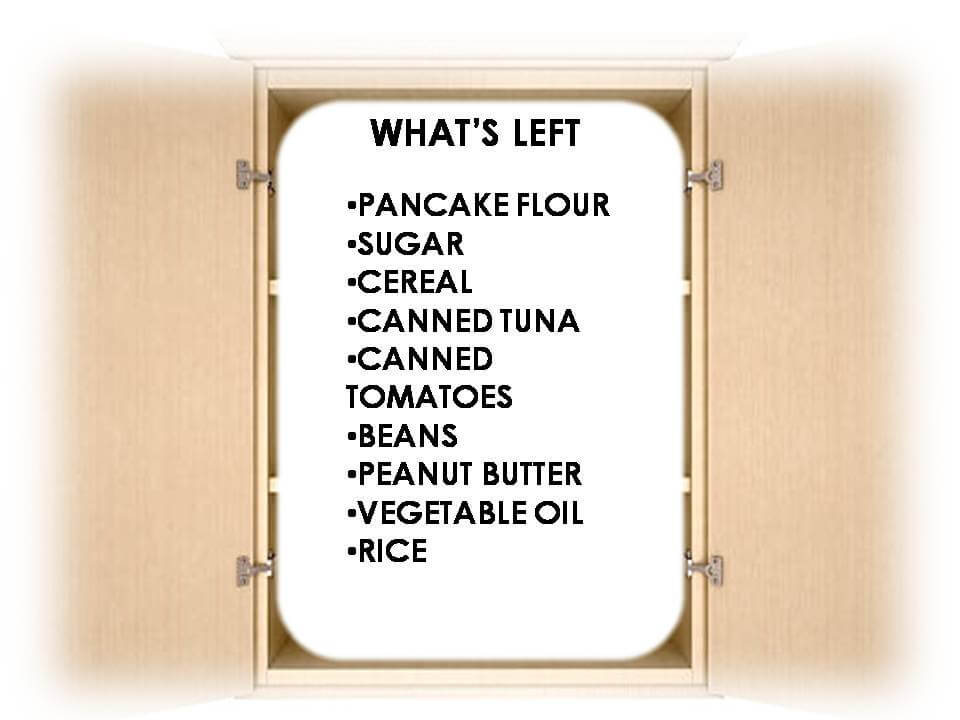
In the real world, this would most likely vary, but it’s a plausible representation of the few things that could be left after a long period of disaster and isolation. Many of the items can be eaten on their own, as is.
But with a bit of creativity and some fundamental knowledge of how to use and combine ingredients, someone could make a surprising range of meals. It’s also probable that there are some obscure spices still around like turmeric and some common ones like salt and pepper.
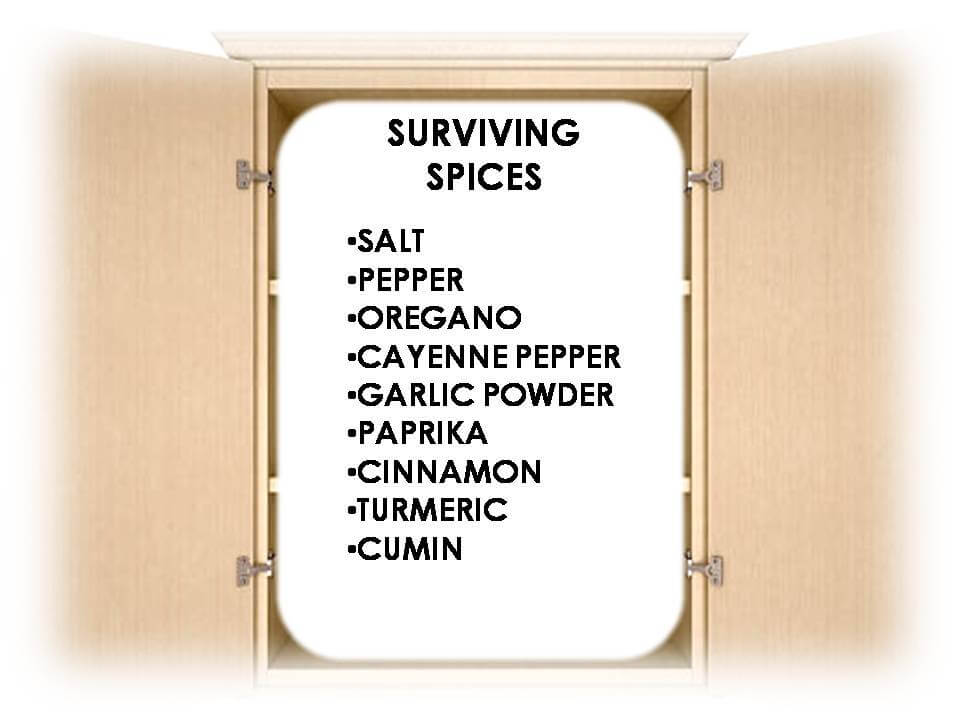
If you look at your own spice cabinet right now you’ll no doubt see many of these and it’s quite possible some have been in there for a while and will most likely still be around when most other things run out.
Some of the recipes we’ll cover call for the use of specific spices, but if you like your food spicy, spice away.
You’re Going to Have to Think like a Chef
The hallmark of a professional chef is that they can be confronted with an odd assortment of ingredients and immediately begin to see possibilities. That’s because they can see the potential of any single ingredient as a staple food item and they understand the concept of cooking.
When most of us look at a box of pancake flour, we see pancakes. A professional chef looks at a box of pancake flour and sees flour infused with baking soda that could serve as a foundation for breads, cakes, muffins, biscuits, cookies, sauce thickeners, pretzels, pasta, and even a pizza crust.
And they don’t stop there.
- When we see sugar, they see a foundation for caramel, rock candy, syrups, and an effective food preservative.
- When we see a can of tuna, they see tuna cakes and casseroles.
- When we see peanut butter, they see peanut butter cookies and peanut butter balls rolled in crushed cereal as a protein treat. Even peanut butter soup.
The list goes on and we’ll get into specifics of how to take those desperate, last ingredients and combine them to make meals that not only satisfy basic nutritional needs, but actually taste good. The better news is that they not only can provide good nutrition but result in many types of food that kids love to eat.
The rules are simple. You can’t shop. You can’t go out and pick something from the garden. You can’t even wild forage. All you can use as an ingredient is what we’ve listed. For anyone, a list like this may be different than what you actually end up with as you endure a long-term disaster, but the idea is to think about how an odd assortment of very few ingredients can actually come together to make a decent meal.
Will It Taste Good?

Actually, yes. Some of these recipes are the same recipes you would put together in a fully stocked kitchen. Others use various substitutions and while it may not taste like mom used to make, they still taste good. Here are some ideas based on what’s left in our survival pantry:
Pancake Flour
Pancake flour is basically flour with the addition of baking powder. Some varieties have additional ingredients like powdered milk and powdered eggs, sugar and salt. It doesn’t matter. The basic combination of flour and baking powder lets you do a lot of things with pancake flour.
One of the keys is proportions of the pancake flour to the water. If you add enough water to make a batter you’ll get pancakes. By reducing the amount of water you’ll get a consistency closer to a dough.
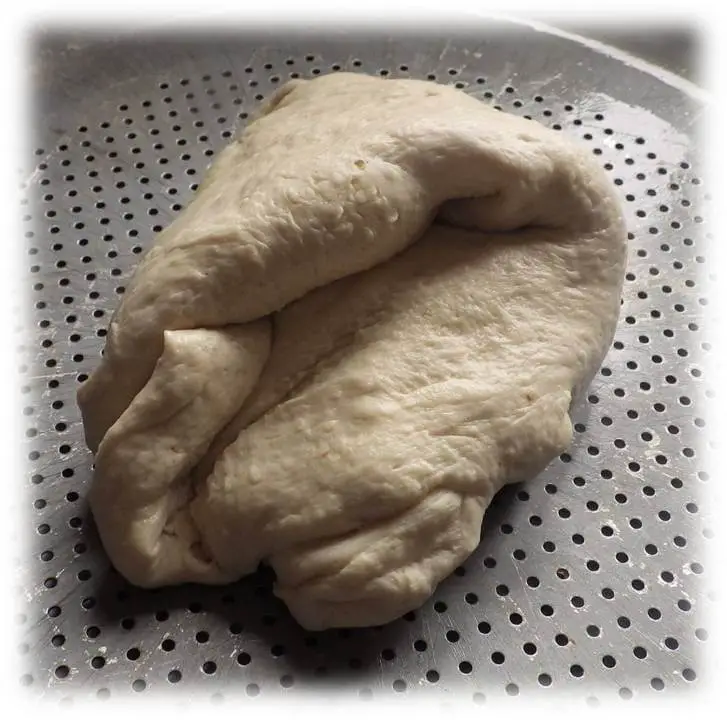
This allows the pancake flour to develop as biscuits, bread or flatbread and even dumplings.
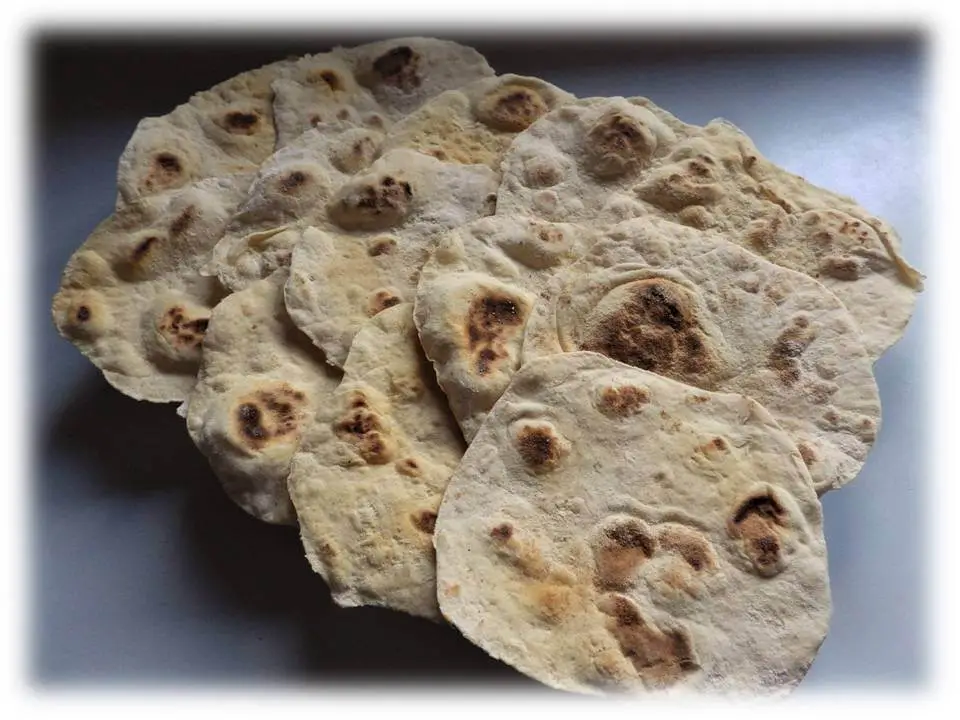
If you roll out the dough very flat you’ll get a very good approximation of a flour tortilla that you can cook on a skillet.
The whole idea is to avoid adding too much water and ending up with a batter. If you do that, you’ll get pancakes and we have a recipe variation for that as well.
Here are some pancake flour recipes to try:
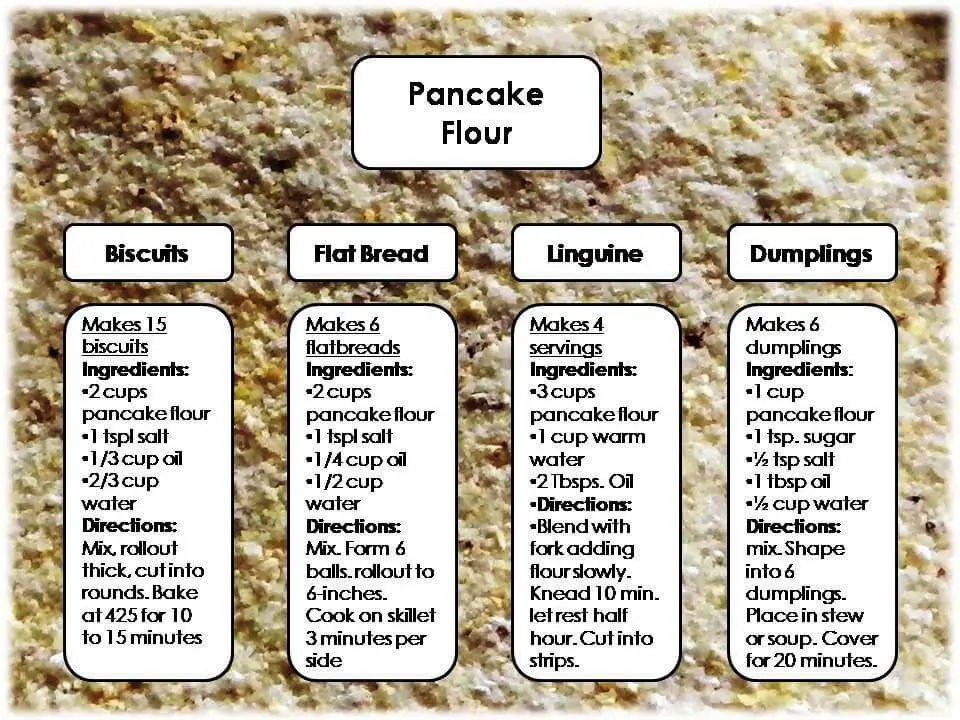
Biscuits (makes 15)
Ingredients:
- 2 cups of pancake flour
- 1 tsp of salt
- 1/3 cup of oil
- 2/3 cup of water
Directions:
- Mix, rollout thick, cut into rounds.
- Bake at 425° F for 10 to 15 minutes.
Flat Bread (makes 6)
Ingredients:
- 2 cups of pancake flour
- 1 tsp of salt
- 1/4 cup of oil
- 1/2 cup of water
Directions:
- Mix ingredients.
- Form 6 balls.
- Rollout to 6 inches.
- Cook on skillet, 3 minutes per side.
Linguine (makes 4 servings)
Ingredients:
- 3 cups of pancake flour
- 1 cup of warm water
- 2 TBS of oil
Directions:
- Blend with fork, adding flour slowly.
- Knead for 10 minutes.
- Let rest for half an hour.
- Cut into strips.
Dumplings (makes 6)
Ingredients:
- 1 cup of pancake flour
- 1 tsp of sugar
- 1/2 tsp of salt
- 1 TBS of oil
- 1/2 cup of water
Directions:
- Shape into 6 dumplings.
- Place in stew or soup.
- Cover for 20 minutes.
Peanut Butter
Peanut butter is another frequent survivor in many pantries. It’s another excellent source of protein and because of its consistency, can be easily used in a variety of recipes from pancakes to peanut butter soup and classic peanut butter cookies.
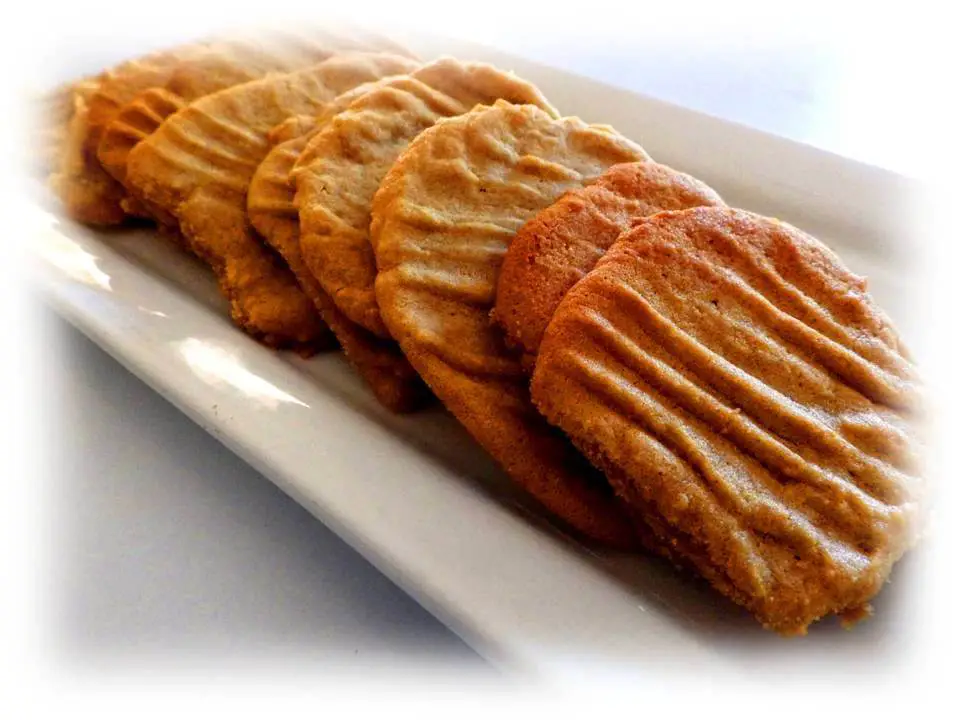
Peanut butter is also high in calories and while that may be something we try to avoid in good times, calories are key in a survival situation.

Cookies
Ingredients:
- 2 1/2 cups of pancake flour
- 1 cup of sugar
- 1/2 tsp of salt
- 1 cup of peanut butter
- 1 cup of oil
Directions:
- Mix all ingredients.
- Mix and roll into balls.
- Flatten with fork.
- Bake at 375° F for 10 minutes.
Protein Balls (makes 16)
Ingredients:
- 2 cups of peanut butter
- 1 cup of cereal
Directions:
- Use two spoons to shape peanut butter into 1/2 inch balls.
- Roll in cereal and serve.
Peanut Butter Soup (makes 4 servings)
Ingredients:
- 2 cups of peanut butter
- 2 cups of water
- 1 tsp of salt
- 1/2 tsp of pepper
Directions:
- Combine ingredients and heat pot.
- Stir over medium heat.
- Serve with bread.
Peanut Pancakes
Ingredients:
- 1 cup of water
- 1/2 cup of peanut butter
- 1 1/4 cups of pancake flour
- 1/4 teaspoon of ground cinnamon
Directions:
- Mix all ingredients and cook on skillet.
- Top with caramel sugar syrup.
Cereal
A box or two of cereal can let you do a lot of things. You can crumble it, crush it, or reduce it to a powdery flour and add it to your pancake flour to stretch it.
You could use it as a breading for fish or anything else, and it can even make a decent loaf of bread when added to pancake flour, although you’ll end up with a loaf that has more of a pound cake consistency rather than the texture of a traditional yeast bread.

We’re going to tough it out and pretend we don’t have any yeast and see how we do. And yes, you can just eat the cereal. But remember—there’s no milk.
Pancake flour and crushed cereal can also be used to thicken a stew or soup. Mix it with a little oil first and it will incorporate easily without lumps. As the soup or stew simmers, it will thicken. How thick depends on how much pancake flour or crushed cereal you add. Start with a teaspoon if you’re trying to thicken something and go from there.

Bread (makes a 1-pound loaf)
Ingredients:
- 1 cup of pulverized cereal
- 1 1/2 cups of pancake flour
- 1 cup of water
Directions:
- Mix into a batter.
- Bake at 425° F for 45 minutes in an oiled bread pan.
Breading
Ingredients:
- 2 cups of cereal
Directions:
- Place cereal in a plastic bag and crush with your hands or a rolling pin.
- Roll fish or chicken in crumbs.
- Fry in oil.
Muffins (makes 6)
Ingredients:
- 3/4 cup of water
- 1 1/2 cups of smashed cereal
- 1 cup of pancake flour
- 1 tsp of cinnamon
- 2 TBS of oil
Directions:
- Mix ingredients together.
- Bake at 400° F for 20 minutes.
Pizza Crust
Ingredients:
- 1 cup of ground cereal
- 1/2 cup of pancake flour
- 1/2 tsp of salt
- 1/2 cup of water
- 2 TBS of oil
Directions:
- Mix, knead, roll out.
- Top with tomatoes, tuna, and beans.
- Bake at 375° F for 15 to 20 minutes.
Beans
Beans always seem to be one of the last things left in the pantry regardless of the circumstances, and that’s a good thing. Whether they’re canned or dry and in a bag, beans can be used in a variety of forms from whole to mashed to reduced to a paste as an ingredient in a range of recipes.
The thing to remember is to “think outside the bean.” Pureed beans with a little oil and spices make a hummus out of any bean. Mashed beans are the foundation of refried beans; make a decent bean burger, and can be spread on anything from rice buns to flatbread to tortillas. The ability to look at any type of food and see its potential in a different form is the key to surviving with few resources.
Beans are also an excellent source of protein adding to the nutritional benefits of any meal.
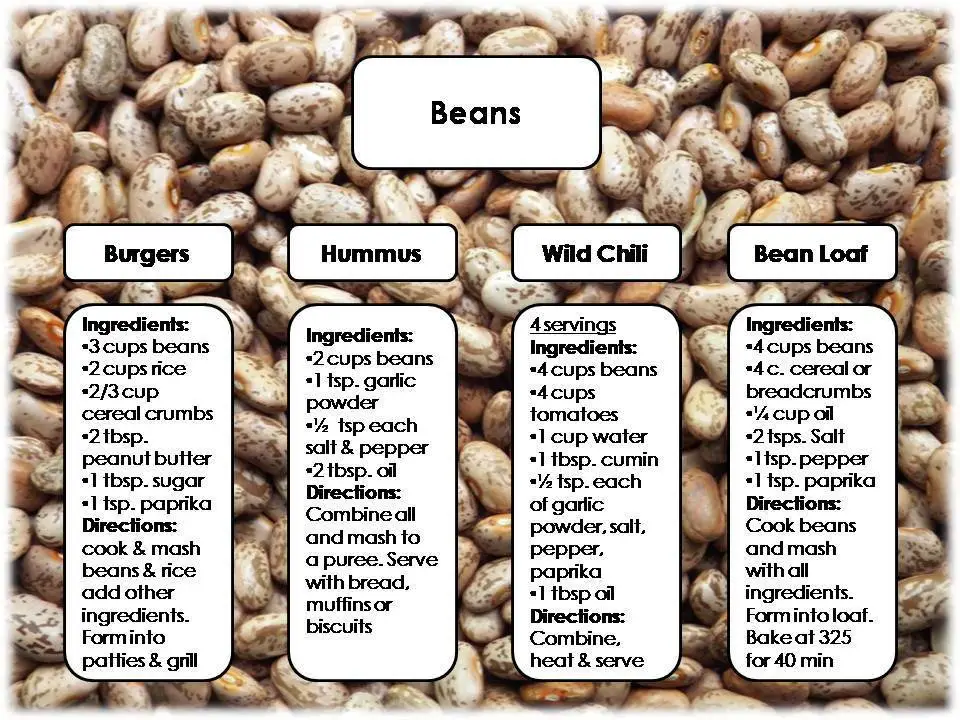
Burgers
Ingredients:
- 3 cups of beans
- 2 cups of rice
- 2/3 cup of cereal crumbs
- 2 TBS of peanut butter
- 1 TBS of sugar
- 1 tsp of paprika
Directions:
- Cook and mash beans and rice.
- Add other ingredients.
- Form into patties and grill.
Hummus
Ingredients:
- 2 cups of beans
- 1 tsp of garlic powder
- 1/2 tsp of salt
- 1/2 tsp of pepper
- 2 TBS of oil
Directions:
- Combine all ingredients and mash into a puree.
- Serve with bread, muffins, or biscuits.
Wild Chili (makes 4 servings)
Ingredients:
- 4 cups of beans
- 4 cups of canned tomatoes
- 1 cup of water
- 1 TBS of cumin
- 1/2 tsp of garlic powder
- 1/2 tsp of salt
- 1/2 tsp of pepper
- 1/2 tsp of paprika
- 1 TBS of oil
Directions:
- Combine ingredients together.
- Heat and serve.
Bean Loaf
Ingredients:
- 4 cups of beans
- 4 cups of cereal or breadcrumbs
- 1/4 cup of oil
- 2 tsp of salt
- 1 tsp of pepper
- 1 tsp of paprika
Directions:
- Cook beans and mash with all ingredients.
- Form into a loaf.
- Bake at 325° F for 40 minutes.
Rice
We’re going to assume there’s a good chance you still have some rice in your post-disaster pantry. If you do, you’re in luck. Cultures around the world have subsisted on rice since the day it was harvested for the first time. Nutritionally, its primary benefit is calories from carbohydrates. The good news is that it’s a primary foundation ingredient for other ingredients to make a meal.
You could also pulverize rice to a powder to make rice flour; cooked and fried in oil in a skillet with your homemade soy sauce to make fried rice, or even add cooked rice to a bread recipe to further extend your available supplies. The trick is to experiment and improvise and if you don’t like the taste, add some salt and sugar.

Rice Bowl (makes 4 servings)
Ingredients:
- 2 cups of rice
- 4 cups of water
- Toppings
Directions:
- Cook rice.
- Place in bowls.
- Top with beans, tomatoes, tuna, and survival soy sauce.
Survival Soy Sauce
Ingredients:
- 1 cup of water
- 1 TBS of salt
- 2 TBS of caramel
Directions:
- Over medium heat, reduce caramel to a deep brown.
- Add water and salt to caramel.
- Stir to dissolve.
Rice Buns
Ingredients:
- 2 cups of cooked rice
- 1 TBS of oil
Directions:
- Roll out cooked rice to 1/2 inch thick.
- Use a bowl to cut circles.
- Gently fry rice in oil in a skillet.
- Use as a bread substitute.
Rice and Beans
Ingredients:
- 2 cups of cooked rice
- 1 cup of beans
- 1 tsp of salt
- Additional spices to suit your taste
Directions:
- Cook rice and beans together.
- Add spices to taste.
Sugar
Regular white sugar is relatively cheap and is usually used as an ingredient in a recipe. However, you can use just sugar to make a variety of things from syrup to caramel, a soy sauce substitute and more.
It also has food preservative properties, particularly when combined with salt, so if you do manage to come across some additional food from hunting or wild foraging, you at least have some options for food preservation without a freezer or refrigerator.

Caramel
Ingredients:
- 1 cup of sugar
- 1/4 cup of water
- 1/2 cup of water (you'll use this water at end of recipe)
Directions:
- Add sugar and 1/4 cup of water to pan.
- Place pan over low heat.
- Stir 15 minutes until dark brown.
- Remove from heat and pour 1/2 cup of water to sugar until dissolved.
Syrup
Ingredients:
- 1 cup of water
- 3 cups of sugar
- 2 TBS of caramel
Directions:
- Boil water
- Add sugar, let it dissolve.
- Stir in caramel, let it cool.
Rock Candy
Ingredients:
- 1 cup of water
- 3 cups of sugar
Directions:
- Boil water.
- Add sugar, let it dissolve.
- Let it cool.
- Dip skewers in solution and roll in sugar.
- Suspend in jars with solution and cover.
- Candy will form in 1 week.
Sugar Cookies
Ingredients:
- 1 cup of oil
- 1 cup of sugar
- 1 cup of peanut butter
- 1/2 tsp of salt
- 3 cups of pancake flour
Directions:
- Mix ingredients together.
- Roll into balls.
- Bake on cookie sheet at 375° F for 10 minutes.
Canned Tuna
Canned tuna is another inexpensive item and it’s not unusual to find some surviving canned tuna at the back of a pantry. That’s more good news because it’s an excellent source of protein and you can take it up a notch as a tuna cake sautéed in oil and even as a casserole with your homemade pasta. You could even use it as a topping on pizza in a pinch. Think of it as anchovies even a kid would eat.
Speaking of anchovies, it would be no surprise if you found some sardines next to the tuna tins. Sardines don’t seem to be consumed with great frequency by most people. You can use sardines the same way you use tuna for the above recipes. In fact, it may make sardines taste better for those who don’t particularly like them.
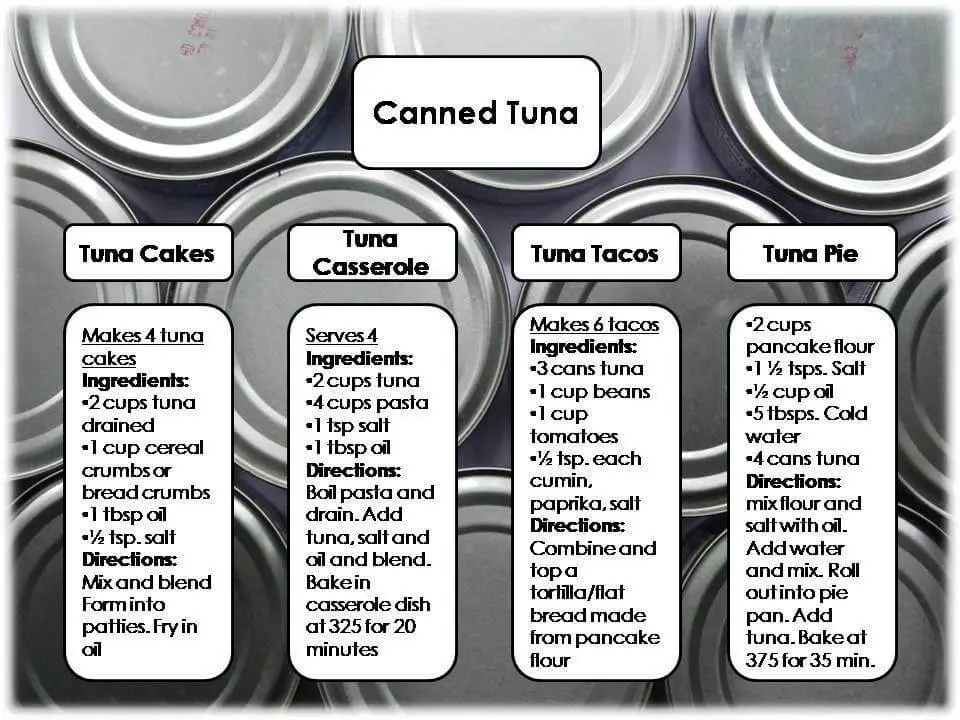
Tuna Cakes (makes 4)
Ingredients:
- 2 cups of tuna, drained
- 1 cup of cereal crumbs or bread crumbs
- 1 TBS of oil
- 1/2 tsp of salt
Directions:
- Mix and blend ingredients.
- Form into patties.
- Fry in oil.
Tuna Casserole (serves 4)
Ingredients:
- 2 cups of tuna
- 4 cups of pasta
- 1 tsp of salt
- 1 TBS of oil
Directions:
- Boil pasta and drain.
- Add tuna, salt, and oil. Blend.
- Bake in casserole dish at 325° F for 20 minutes.
Tuna Tacos (makes 6)
Ingredients:
- 3 cans of tuna
- 1 cup of beans
- 1 cup of tomatoes
- 1/2 tsp of cumin
- 1/2 tsp of paprika
- 1/2 tsp of salt
Directions:
- Combine ingredients.
- Add to tortilla/flatbread made from pancake flour.
Tuna Pie
Ingredients:
- 2 cups of pancake flour
- 1 1/2 tsp of salt
- 1/2 cup of oil
- 5 TBS of cold water
- 4 cans of tuna
Directions:
- Mix flour and salt with oil.
- Add water and mix.
- Roll out into pie pan.
- Add tuna.
- Bake at 375° F for 35 minutes.
Canned Tomatoes
Canned tomatoes are another pantry item that tends to survive in the back of the cupboard after other items are long since gone. This is mostly due to the fact that some of us tend to buy a lot of them because they’re so cheap and rarely eat them on their own.
While the tomatoes can be eaten right out of the can, they can easily make a tomato soup when pureed, serve as a primary topping on a pizza both as a sauce and as chunks, and can be easily added to your beans for chili or used as a component in anything else you might improvise.
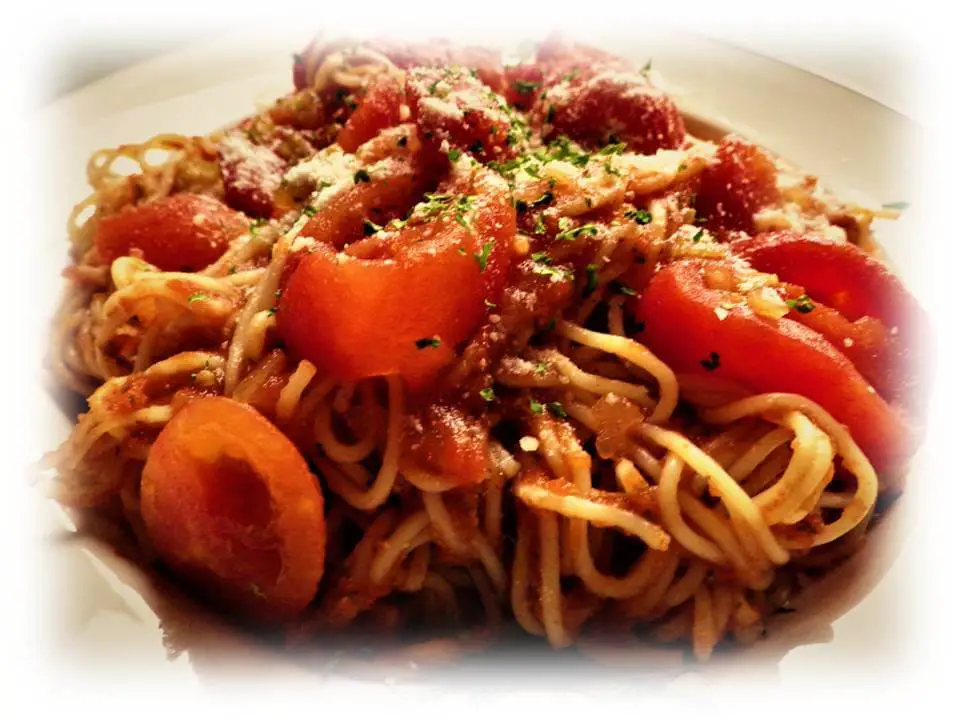
They’re particularly valuable from a nutritional standpoint as a source of Vitamin-C and lycopene. Don’t stay home without them.
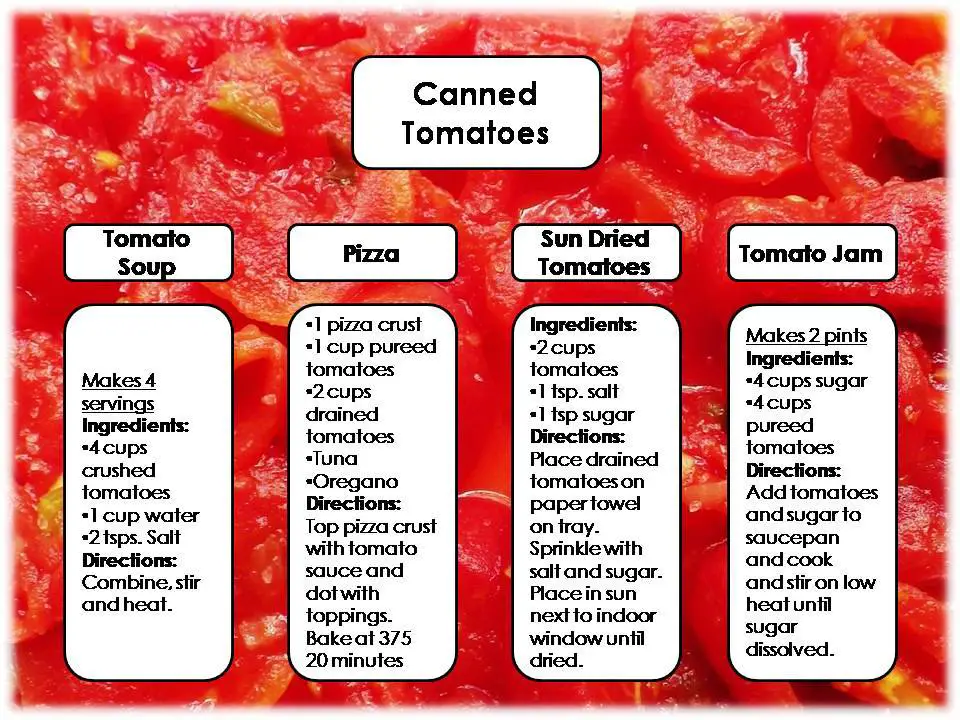
Tomato Soup (makes 4 servings)
Ingredients:
- 4 cups of crushed tomatoes
- 1 cup of water
- 2 tsp of salt
Directions:
- Combine ingredients.
- Stir and heat.
Pizza
Ingredients:
- 1 pizza crust
- 1 cup of pureed tomatoes
- 2 cups of drained tomatoes
- Tuna
- Oregano
Directions:
- Top pizza crust with tomato sauce and dot with toppings.
- Bake at 375° F for 20 minutes.
Sun-Dried Tomatoes
Ingredients:
- 2 cups of tomatoes
- 1 tsp of salt
- 1 tsp of sugar
Directions:
- Place drained tomatoes on paper towel on tray.
- Sprinkle with salt and sugar.
- Place in sun next to indoor window until dried.
Tomato Jam (makes 2 pints)
Ingredients:
- 4 cups of sugar
- 4 cups of pureed tomatoes
Directions:
- Add tomatoes and sugar to saucepan.
- Cook and stir over low heat until sugar dissolves.
Food Substitutes
Ingredients in any recipe affect the shape, form, taste, baking, or cooking characteristics and other factors producing a desired result. In a desperate environment, it’s good to know that there are substitutes for some basic ingredients in the hope that you have at least a viable substitute on hand.
We’ve used many of these substitutions in the recipe ideas we shared. Here are additional possibilities for those times where you have to improvise:
| Ingredient | Amount | Substitution |
|---|---|---|
| Baking mix | 1 cup | 1 cup pancake mix |
| Baking powder | 1 teaspoon | 1/4 teaspoon baking soda plus 1/2 teaspoon cream of tartar OR 1/4 teaspoon baking soda plus 1/2 cup buttermilk (decrease liquid in recipe by 1/2 cup) |
| Baking soda | 1 teaspoon | 4 teaspoons baking powder OR 1 teaspoon potassium bicarbonate and 1/3 teaspoon salt. |
| Bread crumbs | 1 cup | 1 cup cracker crumbs OR 1 cup matzo meal OR 1 cup ground oats or cereal |
| Broth: beef or chicken | 1 cup | 1 bouillon cube plus 1 cup boiling water OR 1 tablespoon soy sauce plus enough water to make 1 cup OR 1 cup vegetable broth. Or just salt |
| 1 cup, packed | 1 cup white sugar plus 1/4 cup molasses and decrease the liquid in recipe by 1/4 cup OR 1 cup white sugar OR 1 1/4 cups confectioners' sugar | |
| Butter (salted) | 1 cup | 1 cup margarine OR 1 cup shortening plus 1/2 teaspoon salt OR 7/8 cup vegetable oil plus 1/2 teaspoon salt OR 7/8 cup lard plus 1/2 teaspoon salt |
| Butter (unsalted) | 1 cup | 1 cup shortening OR 7/8 cup vegetable oil OR 7/8 cup lard |
| Buttermilk | 1 cup | 1 cup yogurt OR 1 tablespoon lemon juice or vinegar plus enough milk to make 1 cup (this assumes some way to refrigerate or chill yogurt or milk) |
| Corn syrup | 1 cup | 1 1/4 cup white sugar plus 1/3 cup water OR 1 cup honey OR 1 cup light treacle |
| Cracker crumbs | 1 cup | 1 cup bread crumbs OR 1 cup matzo meal OR 1 cup ground cereal |
| Egg | 1 whole (3 tablespoons or 1.7 oz) | 2 1/2 tablespoons of powdered egg substitute plus 2 1/2 tablespoons water OR 1/4 cup liquid egg substitute OR 1/4 cup silken tofu pureed OR 3 tablespoons mayonnaise OR half a banana mashed with 1/2 teaspoon baking powder OR 1 tablespoon powdered flax seed soaked in 3 tablespoons water |
| Flour: bread | 1 cup | 1 cup all-purpose flour plus 1 teaspoon wheat gluten |
| Flour: cake | 1 cup | 1 cup all-purpose flour minus 2 tablespoons |
| Flour: self-Rising | 1 cup | 7/8 cup all-purpose flour plus 1 1/2 teaspoons baking powder and 1/2 teaspoon of salt |
| Honey | 1 cup | 1 1/4 cup white sugar plus 1/3 cup water OR 1 cup corn syrup OR 1 cup light treacle syrup |
| Hot pepper sauce | 1 teaspoon | 3/4 teaspoon cayenne pepper plus 1 teaspoon vinegar |
| Lard | 1 cup | 1 cup shortening OR 7/8 cup vegetable oil OR 1 cup butter |
| Margarine | 1 cup | 1 cup shortening plus 1/2 teaspoon salt OR 1 cup butter OR 7/8 cup vegetable oil plus 1/2 teaspoon salt OR 7/8 cup lard plus 1/2 teaspoon salt |
| Milk (whole) | 1 cup | 1 cup soy milk OR 1 cup rice milk OR 1 cup water or juice OR 1/4 cup dry milk powder plus 1 cup water OR 2/3 cup evaporated milk plus 1/3 cup water |
| Molasses | 1 cup | Mix 3/4 cup brown sugar and 1 teaspoon cream of tartar |
| Mustard: prepared | 1 tablespoon | Mix together 1 tablespoon dried mustard, 1 teaspoon water, 1 teaspoon vinegar and 1 teaspoon sugar |
| Rice: white | 1 cup, cooked | 1 cup cooked barley OR 1 cup cooked bulgur OR 1 cup cooked brown or wild rice |
| Saffron | 1/4 teaspoon | 1/4 teaspoon turmeric |
| Shortening | 1 cup | 1 cup butter OR 1 cup margarine minus 1/2 teaspoon salt from recipe |
| Soy sauce | 1/2 cup | 1/4 cup Worcestershire sauce mixed with 1 tablespoon water |
| Stock: beef or chicken | 1 cup | 1 cube beef or chicken bouillon dissolved in 1 cup water |
| Vegetable oil (for baking) | 1 cup | 1 cup applesauce OR 1 cup fruit puree |
| Vinegar | 1 teaspoon | 1 teaspoon lemon or lime juice OR 2 teaspoons white wine |
| White sugar | 1 cup | 1 cup brown sugar OR 1 1/4 cups confectioners' sugar OR 3/4 cup honey OR 3/4 cup corn syrup |
The Fundamental Idea
If you look at the main ingredient in many of the recipes we listed, you can see that it’s all about thinking of it in terms of its primary component and how changing its structure or adding ingredients can bind it into a recognizable and edible form. You also have the option to substitute for ingredients if you have other items on hand.
None of this is Rocket Science.
It’s all about looking at the potential of basic and limited ingredients and thinking about how they can be used to make a meal. In a perfect world, we would have more than a scattering of these meager ingredients.
In fact, this exercise may be enough for some of us to really think twice about what and how much we may stockpile and store. The important thing is to know how to make the best of the least and hopefully get through the worst.
Like this post? Don't Forget to Pin It On Pinterest!
You May Also Like:





Wow great job this information will greatly help when SHTF and to just try for now.